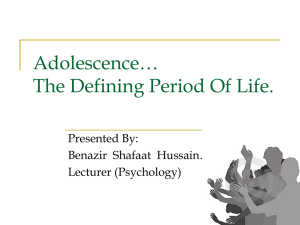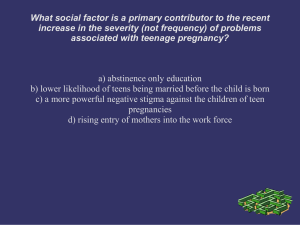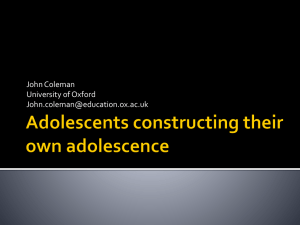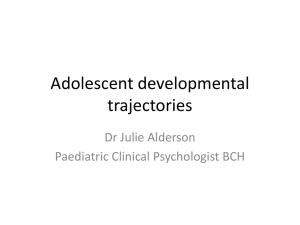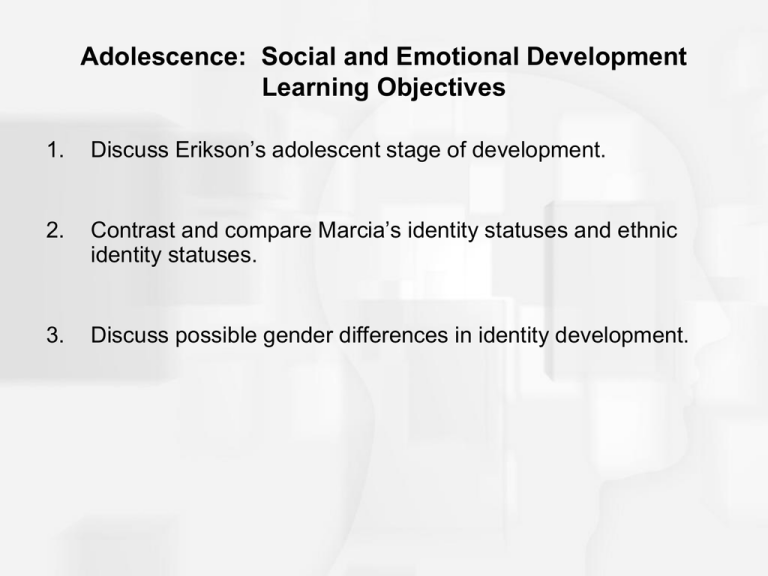
Adolescence: Social and Emotional Development
Learning Objectives
1.
Discuss Erikson’s adolescent stage of development.
2.
Contrast and compare Marcia’s identity statuses and ethnic
identity statuses.
3.
Discuss possible gender differences in identity development.
Adolescence: Social and Emotional Development
Learning Objectives
4.
Describe changes in self-concept and self-esteem during
adolescence.
5.
Discuss adolescents’ relationships with their parents.
6.
Describe cliques, crowds, and developmental changes in
friendship as well as gender differences in friendship.
Adolescence: Social and Emotional Development
Learning Objectives
7.
Discuss how peers influence adolescent development.
8.
Explain how adolescents’ relationships with parents impact
their sexual behavior.
9.
Describe gender differences in masturbation.
Adolescence: Social and Emotional Development
Learning Objectives
10. Explain “coming out” and the impact of sexual orientation on
adolescents.
11. Discuss “nature” and “nurture” evidence for differences in
sexual orientation.
12. Explain hormonal and peer influences on sexual activity in
adolescence.
Adolescence: Social and Emotional Development
Learning Objectives
13. Discuss why 750,000 American teenagers become pregnant
each year.
14. Describe the incidence of juvenile delinquency and risk factors
associated with delinquency.
15. Explain possible reasons for ethnic differences in juvenile
delinquency rates.
Adolescence: Social and Emotional Development
Learning Objectives
16. Describe risk factors and warning signs for adolescent suicide.
17. Discuss what it means to be an adult as well as the concept of
emerging adult.
Adolescence: Social and Emotional Development
Truth or Fiction?
Adolescents imitate their peers’ clothing, speech, hairstyles,
and ideals.
American adolescent males are more concerned about
occupational choices than American adolescent females are.
Adolescence: Social and Emotional Development
Truth or Fiction?
Adolescents are in a constant state of rebellion against their
parents.
Most adolescents’ friends are “bad influences.”
Adolescence: Social and Emotional Development
Truth or Fiction?
Petting is practically universal among American adolescents.
Watching sexy TV shows is a cause of teenage pregnancy.
Adolescence: Social and Emotional Development
Truth or Fiction?
About three-quarters of a million American teenagers become
pregnant each year.
Only a minority of American adolescents engage in delinquent
behavior.
Adolescence: Social and Emotional Development
Truth or Fiction?
Suicide is the leading cause of death among American
adolescents.
Adolescents reach adulthood at age 21.
Development of Identity
and the Self-Concept
“Who Am I?”
(And Who Else?)
What Does Erikson Have to Say About the Development of
Identity During Adolescence?
• Identity versus Identity diffusion
– Primary task – Develop ego identity
• Psychological moratorium
– Experimental period
• Identity crisis
– Successful resolution is understanding who you are and what you
stand for
What Are Marcia’s “Identity Statuses”?
• Four statuses based on two dimensions
– Exploration – active questioning alternatives in search of goals
– Commitment – stable investment in goals
•
•
•
•
Identity diffusion
Foreclosure
Moratorium
Identity achievement
Development of Identity Statuses
• Identity disclosure – least advanced developmentally
• During high school and college, move from diffusion and
foreclosure to moratorium and achievement statuses
• Greatest gains in identity formation occur in college
Ethnicity and Development of Identity
• Development of self-identity is more complex for ethnic minorities
– Need to assimilate two sets of values – dominant and minority
– Prejudice and discrimination
– Fewer educational and career opportunities
• Stages of ethnic identity development
– Unexamined ethnic identity (diffusion or foreclosure)
– Ethnic identity search (moratorium)
– Achieved ethnic identity
Sex and Development of Identity
• Erikson concluded
– Career matters were more important to men
– Relationships were more important to women
• As a result men developed identity before intimacy while women
developed identity and intimacy simultaneously
• Research contradicts this and suggests men and women are
equally concerned about career and interpersonal relationships
– Women more likely to integrate family and career plans
How Does Self-Concept Develop During Adolescence?
• Self-descriptions
– As children, focus on physical characteristics and actions
– As adolescents, incorporate distinct and enduring personality traits
• Self-concepts become more differentiated
– With formal-operational skills, able to integrate contradictory
elements
What Happens to Self-Esteem During Adolescence?
• In early adolescence, self-esteem declines
– Disparity between ideal and real self
• From age 13, self-esteem gradually improves
– May adjust ideas about ideal self
– May become less self-critical
• Emotional support from family and peers is important
– Initially, family support more important
– By late adolescence, peer support is more important
Relationships with Parents
and Peers
How Do Relationships with One’s Parents Change During
the Course of the Teenage Years?
• Time spent with family decreases during adolescence
– Boys tend to spend more time alone
– Girls tend to spend more time with friends
• More time spent with mother
– More conflicts but also more support
• Positive relationships with fathers contribute to psychological
well-being
– Adverse relationships associated with adolescent depression
How Do Relationships with One’s Parents Change During
the Course of the Teenage Years?
• Remaining close to family
– More self-reliant and independent, higher self-esteem and better
school performance
• Conflicts are more frequent
– Based on issues of control
• Parents and adolescents strive for a balance between
independence and family connectedness
How Do Relationships With One’s Parents Change During
the Course of the Teenage Years?
• Parenting Styles
– Authoritative parenting
• Teens show more competent behavior than other groups
• More self-reliant, do better in school
• Better mental health, lowest incidence of problems and
misconduct
How Do Relationships With One’s Peers Change During
the Course of the Teenage Years?
• Role of peers increases throughout adolescence
• Friendships
– More friends than younger children
– One or two “best friends” and several good friends
– Based on acceptance, intimate self-disclosure and mutual
understanding
– Typically same age, race, and sex
• Friendship contributes to
– Positive self-concept and psychological adjustment
Ethnicity, Sex and Adolescent Friendships
• Adolescents choose friends from their ethnic group
– Peers from own ethnic group provide support and reduce isolation
• Intimacy and closeness more central to girls’ friendships
– European American adolescent girls report friendships as more
important than boys do
– African American adolescent boys and girls report same degree of
intimacy and support
• Girls’ friendship networks are smaller and more exclusive
– Girls tend to participate in unstructured activities
– Boys engage in organized group activities
What Kind of Adolescent Peer Groups Are There?
• Cliques
– 5 to 10 people who hang around together
– Shared activities and confidences
• Crowds
– Larger groups who do not spend much time together
– Defined by activity or attitude of group
• Adolescent peer groups
– Spend considerable time together
– Function with little or no adult control
– May include teens of other sex
When Do Romantic Relationships Develop?
• Begin in early to middle adolescence
• Sequence of dating
–
–
–
–
Putting oneself in situations with peers of other sex
Group activities that include peers of other sex
Group dating
Two-person dating
When Do Romantic Relationships Develop?
• Functions of dating
–
–
–
–
Have fun
Enhance prestige with peers
Provide experiences to learn to relate positively with others
Preparation for adult courtship
• Dating in early adolescence
– Casual and short-lived
• Dating in later adolescence
– More stable and committed
How Much Influence Do Peers
Have On Each Other?
• Peer pressure peaks during mid-adolescence
– Peers provide standard for behaviors
– Peers provide support
• Adolescents are influenced by both parents and peers
– Peers influence styles and taste
– Parents influence moral principles and future goals
• Adolescents influence each other both positively and negatively
Social Networking Online
• Two of three American teenagers and young adults use social
networking sites
– Socialize with friends
• Benefits of social networking
– Enhance number of friendships
– Increases self-esteem and sense of well-being
Sexuality
When? What? (How?) Who?
Where? and Why? – Not to
Mention, “Should I?”
What Are Some Patterns of
Sexual Behavior in Adolescence?
• Masturbation
– Most common sexual outlet for teens
– Nearly universal among male teens, less among female teens
• Sexual Orientation
– Sexually attracted to, and interested in forming a relationship
• With people of other sex – Heterosexual
• With people of same sex – Homosexual
• With people of either sex – Bisexual
– One may engage in sexual activity outside of sexual orientation
A Closer Look – Real Life
(and Death)
Sexting: One More Way for
Adolescents to Stay in Touch
Homosexual Sexual Orientation
• Stages of sexual identity for gay males and lesbians
–
–
–
–
Attraction to members of same sex
Self-labeling as gay or lesbian
Sexual contact with members of same sex
Disclosure of sexual orientation to others
• Coming out
– Accepting one’s homosexuality and declaring it to others
– Depression and suicide - higher among gay youth
What Do We Know About the Origins
of Gay and Lesbian Sexual Orientation
• Learning theorists
– Reinforcement and observational learning
• Aware of sexual orientation before experience sexual contact
• Societal condemnation provide few positive effects
• Genetic factors
– Sibling and twin studies
• Sex hormones
– Sexual orientation not reliably connected with adults levels of sex
hormones
– May effect developing embryo and fetus
Male and Female Sexual Behavior
• Adolescents begin dating earlier than past generations
– Earlier dating – more likely to engage in sexual activity in high school
– Initiate sexual activity earlier – less likely to use contraception
• Incidence of oral sex increases with age
• Most teenagers do not plan their first sexual experience
A Closer Look – Research
Do Sexy TV Shows Encourage
Sexual Behavior in Teenagers and
Lead to Teenage Pregnancy?
Why Do Some Teenagers Initiate Sexual Activity at an
Early Age, While Others Wait Until Later?
• Effects of puberty
– Social factors may regulate sexual behavior more in girls
– Early onset puberty – earlier sexual activity
• Parental influences
– Close relationship with parents – less early sexual activity
• Peer influences
– Predictor of sexual activity
• Sexual activity of best friend
Percentage of High School Students Who Have Ever
Had Sexual Intercourse, by Race/Ethnicity and Year –
United States
Figure 16.1
Teenage Pregnancy
• Throughout history, girls were first becoming pregnant during teens
– In US today, 9 in 10 teens who become pregnant do so accidentally
and without committed partners
• Reasons for teenage pregnancy in US
– Little advice on handling sexual advances
– Failure to use contraception
– Pregnancy may be used to force a commitment, rebel against a
parent or moral standards
– Miscalculate odds of getting pregnant
Percentage of Sexually Active High School Students
Who Used a Condom during Last Sexual Intercourse,
by Race/Ethnicity and Year – United States
Figure 16.2
What Are the Consequences
of Teenage Pregnancy?
• Consequences for pregnant teen
– More likely to experience medical complications
– Less likely to complete education
– Lower salaries
• Consequences for teen father
– Lower grades in school than peers
– Enter workforce at earlier age
• Consequences for children of teen mom
– Lower cognitive functions
– More behavioral, emotional problems
– More likely to become teen parent
• Consequences result from socially and economically deprived
environments, not from the mother’s age
Preventing Teenage Pregnancy
• Sex education programs
• Successful programs
– Increase knowledge about sexuality
– Delay onset of sexual activity
• School-based clinics that distribute contraceptives
– Birthrates often drop significantly
• Abstinence-only programs
– No effect on teenage pregnancy rates
A Closer Look – Research
How the Centers for Disease Control
Gathered Its Information
A Closer Look – Research
What Parents Want from
Sex Education Courses
Juvenile Delinquency
What Is Juvenile Delinquency?
• Illegal activities committed by child or adolescent and come into
contact with the criminal justice system
– Some activities are illegal only if committed by minors
• Status offenses
• Ethnicity
– Factors for overrepresentation of African American youth in
juvenile justice system
• Differential offending hypothesis
• Differential treatment hypothesis
• Economic and family factors
The Delinquency Case Rate per 1,000 Juveniles
Figure 16.3
Living Arrangements of Children
According to Race and Ethnicity
Figure 16.4
What Are the Sex Differences
in Delinquent Behavior?
• Boys more likely to engage in delinquent behaviors
• Boys commit more crimes of violence
• Girls commit more status offenses
– Running away and truancy
Who Is Most Likely to Engage
in Delinquent Behavior?
• Many risk factors – causality is not clear
–
–
–
–
–
–
–
–
Early aggressive, antisocial, or hyperactive behaviors
Low verbal IQ, immature moral reasoning
Low self-esteem and impulsivity
Parents and/or siblings have been involved in antisocial behaviors
Little interest and poor performance in school
Early substance abuse, early sexuality
Delinquent friends
Use of violence in interactions
Who Is Most Likely to Engage
in Delinquent Behavior?
• Family Factors
–
–
–
–
–
Lax and ineffective discipline
Low levels of affection
High levels of conflict, abuse, punishment, and neglect
Parents, siblings, and neighborhoods
Prenatal smoking by mother
Prevention and Treatment
of Juvenile Delinquency
• Focus on individual offender
• Focus on systems
– Family, peer groups, school, community
• Early childhood intervention programs
Suicide
When the Adolescent Has Nothing
– Except Everything – to Lose
How Many Adolescents Commit Suicide? Why?
• Among adolescents – suicide is 3rd leading cause of death
• Risk factors in suicide – areas of psychological problems
–
–
–
–
Confusion about self
Impulsiveness
Emotional instability
Interpersonal problems
• Contributors to adolescent suicidal behavior
–
–
–
–
Post-traumatic events
Concerns about sexuality
Pressures to achieve
Anxiety
A Closer Look – Diversity
Ethnicity, Sex, and Suicide
How Many Adolescents Commit Suicide? Why?
• Suicide runs in families
– Genetics
– Socially impoverished family environment
– Poor problem-solving
A Closer Look – Real Life
Warning Signs of Suicide
Emerging Adulthood
Bridging Adolescence
and the Life Beyond
How Do We Define Adulthood?
• Many different criterion for adulthood
– Historically – defined by what people do
• Marriage has been a key criterion
• Holding full-time job, living independent from parents
– Today – marked by adjustment issues
• Deciding on ones values and beliefs
• Accepting self-responsibility
• Becoming financially independent
• Equal relationship with parents
What is “Emerging Adulthood”?
• Bridges adolescence and young adulthood
– Extended period for exploration
– Appear in affluent societies
• Erikson’s moratorium
– Recognized developed nations elongate period of adolescence
– Extended search for identity
Subjective Conceptions of Adult Status
in Response to the Question,
Do You Feel That You Have Reached Adulthood?
Figure 16.6





